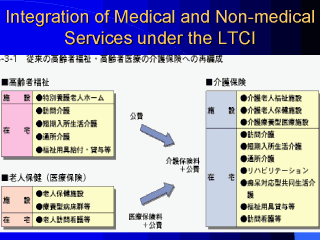 |
Medical and non-medical
services were not in a competitive relationship before the LTCI system was implemented:
medical services were reimbursed by the Elderly Health Care system and non-medical
services were financed by welfare system. However the LTCI system brought both sectors
into a competitive relationship in which one's gain is another's loss, because they have
to compete over the fixed "pie" of budgetary cap. The picture illustrates that
welfare services (nursing homes, home help etc) and medical services (SNFs, geriatric
hospitals, visiting nursing services) [shown left] were integrated into a common funding
system of the LTCI [right]. |
